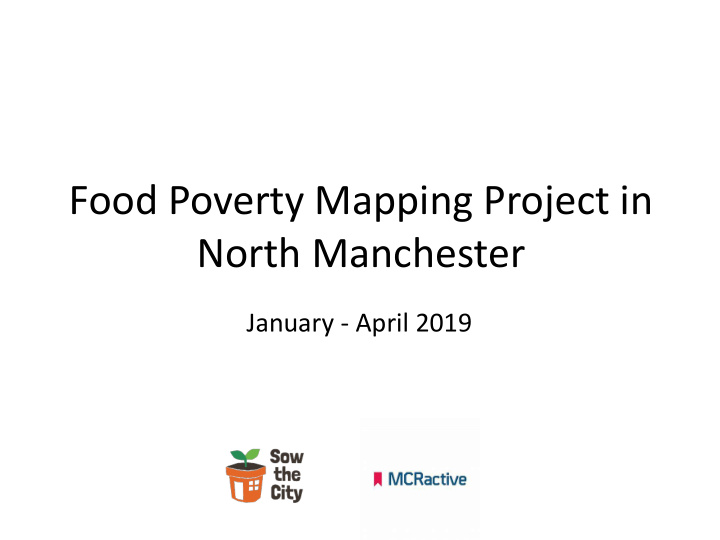



Food Poverty Mapping Project in North Manchester January - April 2019
Contents • Project overview • What is Food Poverty? • Health consequences of food poverty • Local context • Our methodology • Recommendations
Project aim To map and identify gaps in provision of healthy food in North Manchester
Project overview • Sow the City commissioned by Winning Hearts and Minds Programme (Mcr Active) • Winnings Hearts and Minds is a Manchester Health and Care Commissioning and Sport England funded programme to improve people’s long term heart and mental health • Programme includes 4 workstreams: community led approaches, healthy lifestyles, healthy hearts, and healthy minds.
What is food poverty? Inability to access healthy and affordable food: • Having limited money for food after paying for other household expenses; • Living in areas where food choice is restricted by local availability and lack of transport; • Lacking knowledge, skills, cooking equipment or space necessary to prepare healthy meals.
What is food poverty? Food desert = an urban area in which it is difficult to buy affordable or good-quality fresh food. Food savannah = access with 10 mins Food oasis = access within 5 mins Food swamp = only access to take away’s in vicinity
Health consequences of food poverty: • Heart disease and stroke • Some cancers; • Type 2 diabetes; • Poor mental health; • Poor oral health; • Increased falls and fractures in older people; • Low birth-weight and increased childhood morbidity and mortality
Our methodology • Used a Geographical Information System (GIS) for mapping. • Based on Royal Borough of Greenwich Food Poverty Needs Assessment 2016. • Food retailers selling Fresh Fruit and Vegetable categorised : Markets, Supermarkets (> 280 sqm), Grocery Stores (< 280 sqm). • Fresh fruit and vegetables (FFV) = selling at least 2 products. • Accessibility to food retailers measured in terms of walking distance, defined as 500m distance from the retailer (10 mins walk).
Our methodology Indices of MCC Multiple environmental Ward Deprivation health retailer boundaries (IMD) data (incomplete) DESK BASED Develop Geographical Information System WORK (GIS) base map SITE Discussions with Visit to shops to SURVEY shopkeepers check if sell FFV Verify with local community champions FINALISE Develop final maps
Food Poverty Map for North Manchester Notes This is a Food Poverty Map for North Manchester prepared by Sow the City using a Geographical Information System (GIS). The map contains 3 layers of data: 1) Indices of Multiple Deprivation (IMD) data 2015 - a measure of relative deprivation used to rank neighbourhoods across the UK. 2) Food Retailers with a good provision = 5 or more Fresh Fruit and Vegetables (FFV) and Food Retailers with limited provision = 2 or more Fresh Fruit and Vegetables (FFV). 3) Community food growing projects where people can grow fruit and vegetables in a community setting. Accessibility to food retailers is measured in terms of walking distance, defined as 500m distance from the retailer (10 mins walk). The methodology was based on the Greenwich Food Poverty Needs Assessment 2016. Sow the City CIC Ltd 9 Wilcock St Tel: 0161 465 6954 Manchester info@sowthecity.org M16 7DA Project: Food Poverty Mapping Nth Mcr (Hearts and Minds Programme) Date: April 2019 Drawing no: Final
Moston high street Mainly take away and fast food outlets
Ancoats shop Small range of FFV “Can’t compete with Aldi” (Shopkeeper)
Collyhurst Common site in small retailers: onions, garlic and potatoes only veg available
Findings Only a preliminary study and more research is required but there is evidence that: • Areas of North Manchester are food deserts (e.g. some parts of Harpurhey, Clayton, Newton Heath) • Market forces mean that small retailers are not always able to compete with supermarkets on the price of FFV and tend to sell ready meals/ confectionary only with long shelf life and bigger mark up. • Whilst supermarkets and Asian/ polish stores had good provision of FFV smaller shops out of district centres tended to have limited provision.
Recommendations • Collect more information first hand from people in food poverty (e.g. food banks). • Expand the Food Poverty map across Greater Manchester. • Target interventions to tackle food poverty in food deserts e.g. promote healthy and sustainable food through healthy cooking programmes, improve access to healthy food through community food growing.
Recommendations • Community gardens, farmers markets and pocket markets are visible and local solutions to tackling food deserts. They can reach people who might not otherwise purchase fresh fruit or vegetables. • Community food projects can also target vulnerable populations and specific service users (hospitals, housing associations, neighbourhood centres, schools, employers).
Ideas
Recommend
More recommend